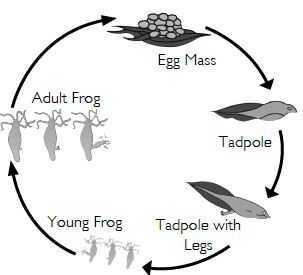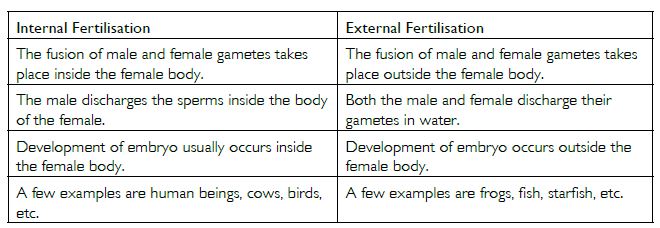Question 1:
Explain the importance of reproduction in organisms.
Answer:
Reproduction is an important biological process because it ensures the existence and continuity of a species. It also helps in the transmission of heredity from one generation to another.
Question 2:
Describe the process of fertilisation in human beings.
Answer:
The first step in the process of reproduction in human beings is the fusion of a sperm and an ovum or egg. Millions of sperms are released into the female’s body out of which only one of the sperms may fuse with the egg. Such fusion of the egg and the sperm is called fertilisation. During fertilisation, the nucleus of the sperm and the egg fuse to form a single nucleus.. The zygote thus formed is the beginning of a new individual.
Question 3:
Internal fertilisation occurs
- in female body
- outside female body
- in male body
- outside male body
Answer:
in female body
Question 4:
A tadpole develops into an adult frog by the process of
- fertilisation
- metamorphosis
- embedding
- budding
Answer:
metamorphosis
Question 5:
The number of nuclei present in a zygote is
- none
- one
- two
- four
Answer:
one
Question 6:
Oviparous animals give birth to young ones.
- TRUE
- FALSE
Answer:
FALSE
Question 7:
Each sperm is a single cell.
- TRUE
- FALSE
Answer:
TRUE
Question 8:
External fertilisation takes place in frogs.
- TRUE
- FALSE
Answer:
TRUE
Question 9:
A new human individual develops from a cell called gamete.
- TRUE
- FALSE
Answer:
FALSE
Question 10:
Egg laid after fertilisation is made up of a single cell.
- TRUE
- FALSE
Answer:
TRUE
Question 11:
Amoeba reproduces by budding.
- TRUE
- FALSE
Answer:
FALSE
Question 12:
Fertilisation is necessary even in asexual reproduction.
- TRUE
- FALSE
Answer:
FALSE
Question 13:
Binary fission is a method of asexual reproduction.
- TRUE
- FALSE
Answer:
TRUE
Question 14:
A zygote is formed as a result of fertilisation.
- TRUE
- FALSE
Answer:
TRUE
Question 15:
An embryo is made up of a single cell.
- TRUE
- FALSE
Answer:
FALSE
Question 16:
Give two differences between a zygote and a foetus.
Answer:
Question 17:
Define asexual reproduction. Describe two methods of asexual reproduction in animals.
Answer:
The type of reproduction in which only a single parent is involved is called asexual reproduction. Following are the two methods of asexual reproduction in animals:
Question 18:
In which female reproductive organ does the embryo get embedded?
Answer:
The embryo gets embedded in the walls of the uterus.
Question 19:
What is metamorphosis? Give examples.
Answer:
Metamorphosis is the drastic change that takes place during the development of an animal from the larval to the adult stage.
The above figure shows three stages in the development of a frog. egg, tadpole or larva and the adult frog.
The tadpole or larva is totally different from its adult form. Tadpole has gills for respiration because it lives in water. During metamorphosis the body of the tadpole undergoes changes to become an adult frog. For example, the gills are replaced by lungs. Another animal in which metamorphosis takes place is the silkworm.
Question 20:
Differentiate between internal fertilisation and external fertilisation.
Answer:
Question 21:
Complete the crossword puzzle using the hints given below.






